
I am on a tour of the three Baltic States. Having visited Lithuania and Latvia, we are now driving up the coastal highway north of Jūrmala in Latvia towards Estonia. Estonia is the smallest of the Baltic countries with a population of a mere 1.3 million. The language moreover, is Finno-Ugric, sharing a common root with Hungarian and Finnish, while the languages of Latvia and Lithuania are Indo-European. According to our guide, Estonia is doing the best, economically speaking, of the three countries, in some part due to investment from Finland but, less positively perhaps, is also the most expensive to live in.
Pärnu
We cross the border and head towards Pärnu, another Baltic Sea resort, known as “the Summer Capital.” There are three language groups aboard the coach now: the Spanish, German and English. The Italians have been shifted to another smaller vehicle. However, we have been joined by a further small group of English speakers, who had toured a slightly different route via the coast of Lithuania to visit Klaipeda, Lithuania’s main seaport. A couple of them managed to grab the front seat before we got there. Pity, but I suppose it might be considered unfair if we hog it all the time. Pärnu is a holiday destination for many Finns, Germans and Swedes, we are told. Today, however, it is jolly windy, quite different to our experience in Jūrmala. The shallow Baltic seas are steep and short and not conducive to paddling in. But the town has some walkable streets and attractive old houses to look at. It was a Hanseatic port in the 14th century. We lunch on hot soup in a backstreet.
Tallinn Song Festival Ground
Tallinn is only an hour or so north of Pärnu and we alight first at the Tallinn Song Festival Grounds, in which is a huge arched stage for musical performances. “In 1988 the Singing Revolution was held here,” our guide informs us. “This is where patriotic Estonians sang for independence from the Soviet Union”. A bronze statue of the Estonian composer, Gustav Ernesats, sits on the grassy slope with his eyes on the stage. He composed the unofficial anthem which Estonians sang during this period. There have been many notable performers in the grounds since then, such as Madonna and Michael Jackson, with over 70,000 people attending. Impressive view from here. On the sea in the distance I spot two cruise ships.
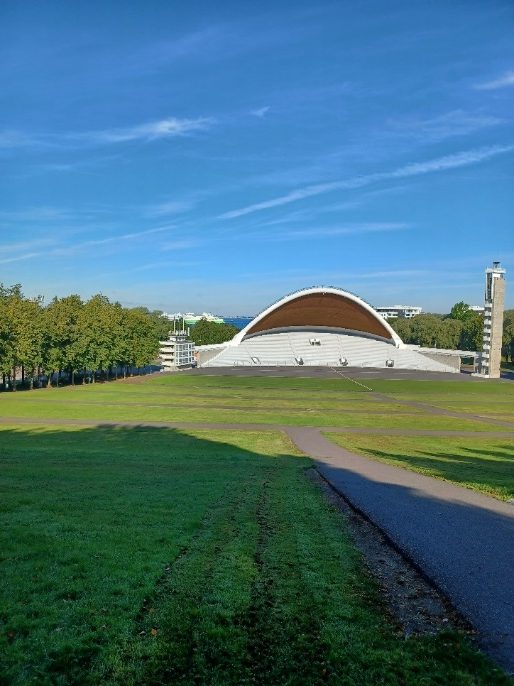
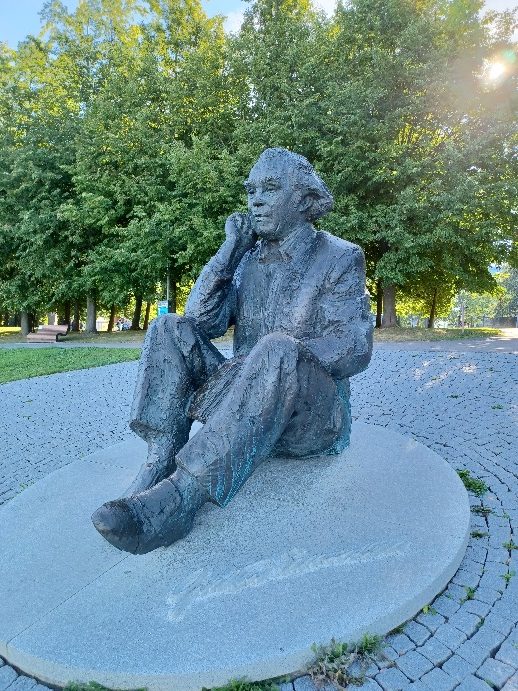
Tallinn
We proceed to the old city, which is half surrounded by the 13th – 16th century city wall with its still extant 26 defensive towers and two complete gates. Inside is the medieval town with its churches, cobbled streets, colourful houses and markets. Very attractive. It is more hilly than the other two capitals and there are two parts to it, the Lower Town and Toompea Hill. The two parts are joined by two ‘legs’. The tour takes us up the straight and wide ‘Pikk jalg’ (‘Long Leg street,’) which was once used for carriage traffic, and later we go back down ‘Lϋhike jalg’ (‘Short Leg street’), a narrow winding passageway with many steps. “The nobility lived on Toompea Hill and looked down upon the lesser folk in the Lower Town below”, our guide explains. T’was ever thus.
Toompea Hill
In a prominent position atop Toompea Hill is the imposing onion domed Russian Orthodox church, the Alexander Nevsky Cathedral, with its white buttresses and double arched portico. Of course, we peek inside its lavish interior and it is all awesome. However, it is a trifle difficult to work up enthusiasm for admiring such works of art and architecture when one is a) thirsty and b) flagging. Just off the square is a little café. “Let’s get there before the rest of them”, exhorts my Polish friend. We secure a tempting table, on top of which is a pot of pink geraniums, and sink back on soft cushioned seats in the sunshine. Sunglasses and smiles. A fine setting to drink drinks and talk about nothing in particular.
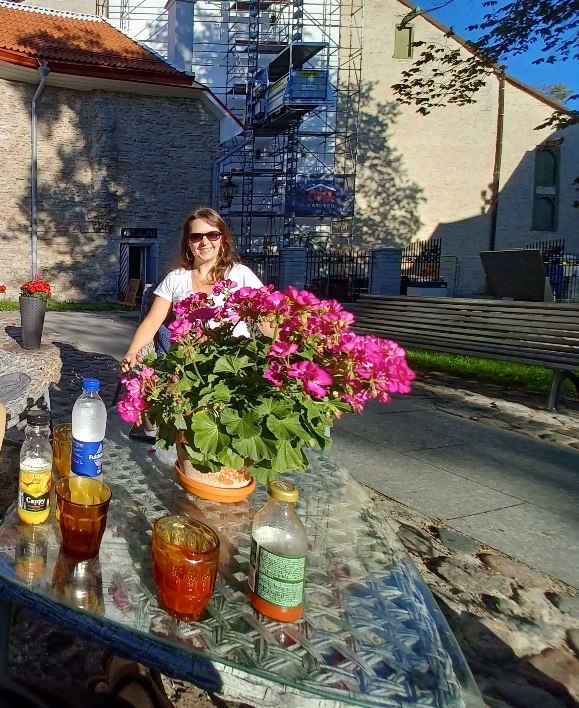
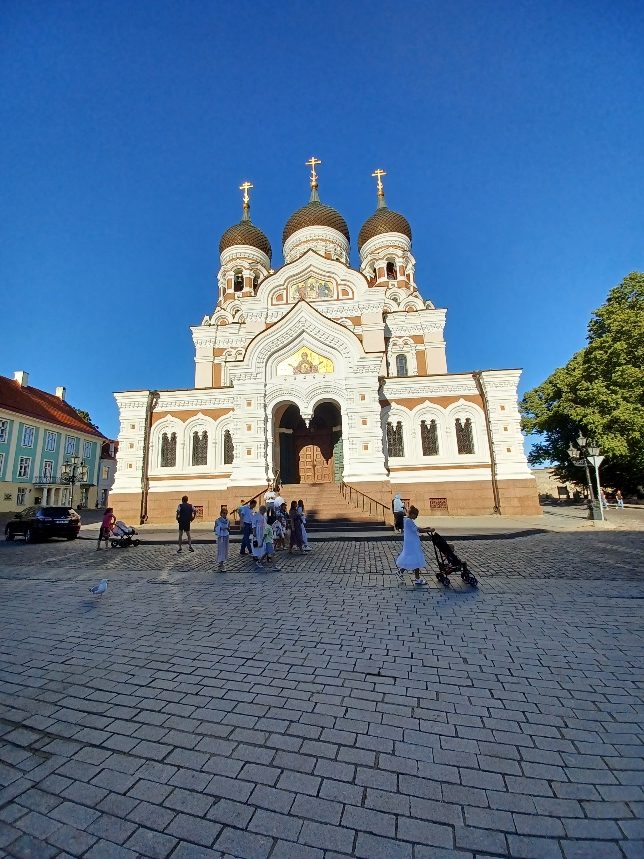
After refreshment, we drift over to view the pale pink building of the Estonian Parliament, the Riigikogu building, located in what was Toompea Castle. “ There was once a wooden fortress here”, our guide informs us. But I gather the Parliament building was constructed in the early 1920s. Lovely garden in front of it. Much camera snapping.
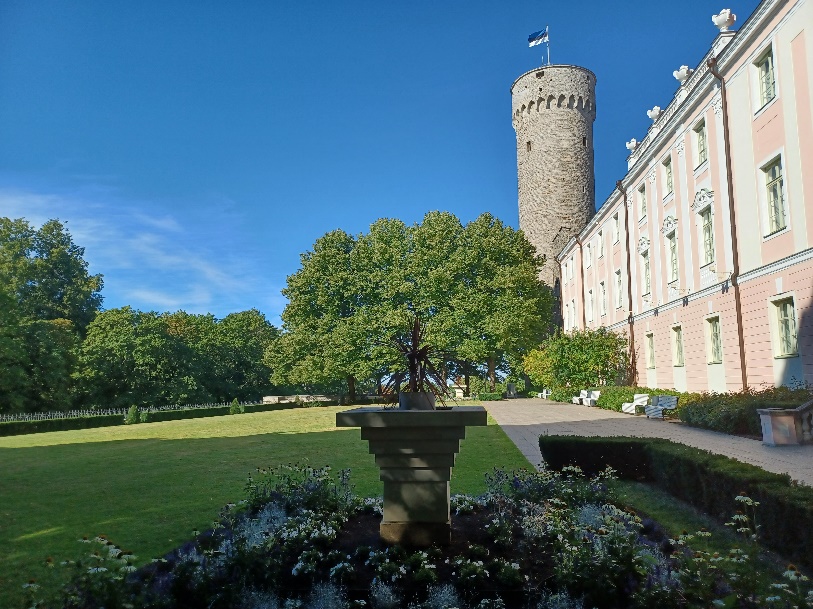
Lϋhike jalg (Short Leg street) and the King of Denmark Garden
Now begins the descent through the gate tower of the Short Leg down narrow cobbled streets. The gate tower is one of four medieval towers of a huge fortification, which includes the delightfully named Kiek in de Kök. “It means peep into the kitchen”, our guide informs us, as those inside the tower could see into others’ windows. Close by is the King of Denmark garden, which was given to the Lower Town in the 14th century. Serving at various times as a market place for fish, flowers and a public garden, it now glories in a recent art installation of three 2.5 metre high bronze statues of monks, named ‘Three’. They stand in various poses: Ambrosius, Bartholomeus and Claudius, the ‘Waiting Monk’, the ‘Praying Monk’ and the ‘Watching Monk’ respectively. But they have no faces, just the hoods of their habits. “This is the most haunted area of the city. Spooky at night-time!” says our guide gleefully. Worth missing then. Not sure I would wish to encounter those faceless monks alongside those darkened ancient fortifications.
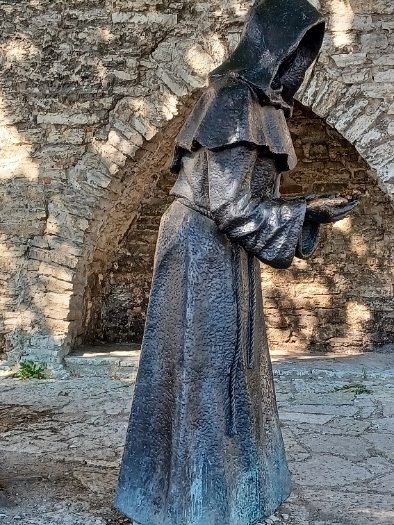
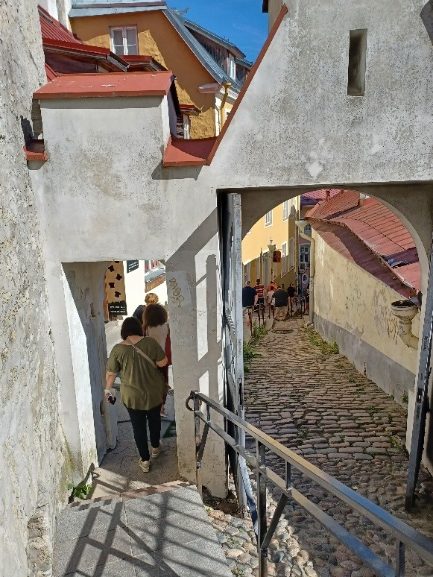
Of further significance, we are told, the origin of the Danish national flag, the ‘Dannebrog’, was at this spot. Legend has it that, during the campaign of the Danish King Valdemar II in 1219, prayers were said by monks for God’s help when defeat looked imminent. Whereupon a red cloth with white cross fluttered down from heaven. This ‘sign’ gave a significant morale booster to the Danes and resulted in victory over Estonia. The Danes ruled in Tallinn for over a hundred years thereafter.
Lower Town, Tallinn
We descend past yellow and pink houses with flowers in window boxes and the painted signs of art galleries and handicraft shops. At the foot of the Short leg, we wander round the sites of the old town. Here we see the Three Sisters Hotel, a group of three old merchant houses, reminiscent of the Three Brothers in Riga. We see St Olaf’s church, a medieval building, bright white with a very tall spire, which towers above the buildings of the old town. “This building was used by the Soviet’s KGB as a radio tower during the occupation”, our guide tells us. Nearby is the notorious KGB building, the KGB’s former headquarters, where prisoners were tortured or worse in the prison cells in the basement. They serve now as a symbol of Soviet oppression. In front of the Russian Embassy, like we saw in Riga, are protest notices, such as: ‘No War’ and ‘Russia is a Terrorist State’ attached to the railings. Baby clothes are pegged to the Ukrainian flag and soft toys lie on the pavement below.
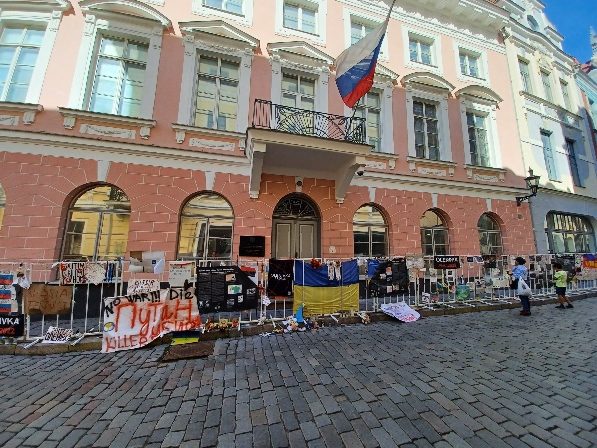
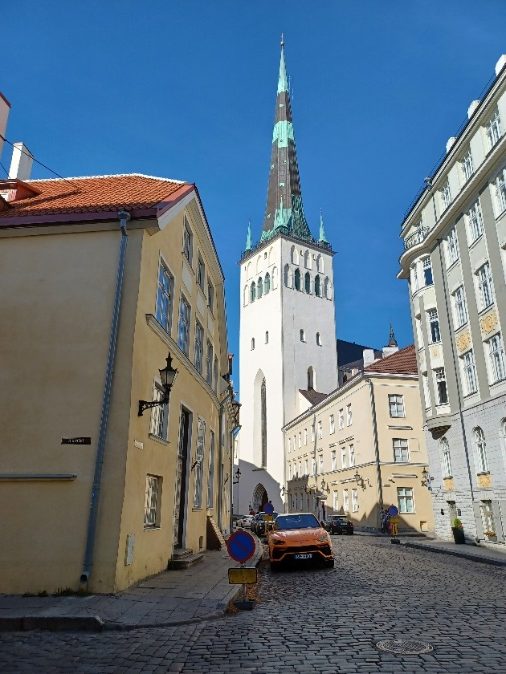
I expected to find some evidence of Jews living in Tallinn, but the city had no Jewish ghetto. Most Jews, who were living there in 1941, fled to the USSR, being aware of what had happened elsewhere. But forced labour camps were formed in the country, to which Jews from other European countries were deported. Thousands were murdered and others died on death marches along the Baltic coast. Virtually no Jew who remained in Estonia survived under the Nazis.
After the formal tour I continue to stroll round the Lower town, the hub of which is the sizeable Town Hall Square. This is where goods were traded in the time of the Hanseatic League. I visit the old Pharmacy building on one side of the square. It dates from medieval times but business carries on as usual. Town Hall Square is full of colourful medieval buildings of different shapes and sizes with the fifteenth century Gothic town hall dominating one side and restaurants and cafés abounding on the other sides. An accordion player serenades the throng of visitors. I sit in a café and listen awhile. I like accordions.
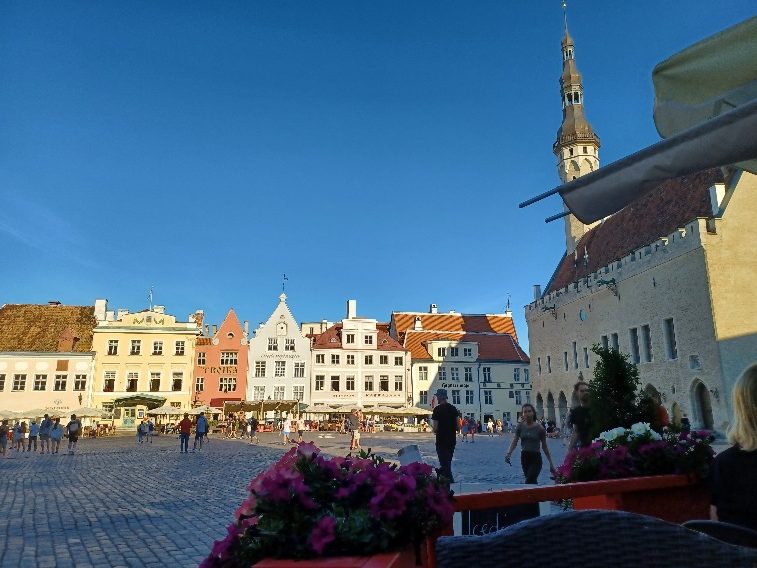
Thence to wander round the old walls of the Lower Town to do a bit of tower spotting. ‘Fat Margaret’ hoves into view, a massive round defensive structure built to defend the harbour. Its walls are up to five metres thick. Attached to it is the Great Coastal Gate, one of the many gates controlling access to the city. Then there is the horseshoe shaped Bremen gate; the Tower behind Monks, Hellemann Tower; and the stunning Viru gate with two tall stone towers with their red tiled rooves either side. There is a large flower stall outside this gate. Huge sunflowers, gladioli, daisies, lilies, are on display. Two young boys wearing New York tee shirts wander amongst the flowers.
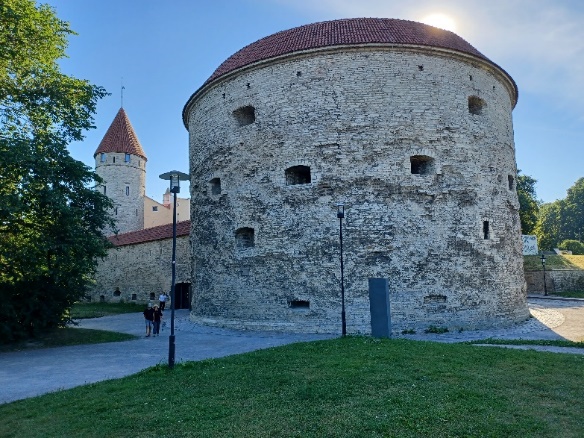
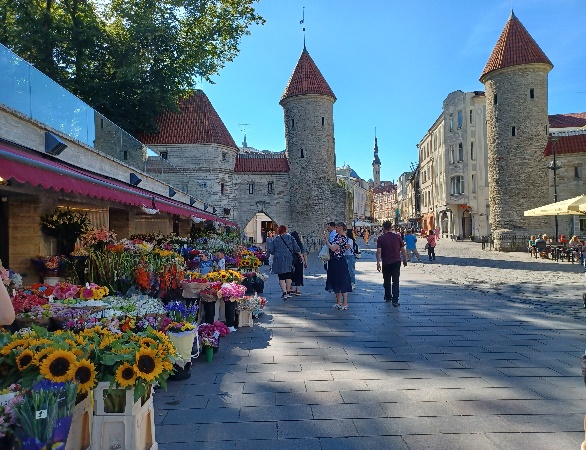
Many of the group members meet up at the ‘Peppersack’ for dinner. With its steep peaked roof, vaulted ceilings, painted walls, and wooden tables, along with waiters in national dress, it is an atmospheric venue. The food is tremendous.

Laheema National Park
It is the last day and I am joining an optional excursion to Laheema National Park. Exciting and lively though these medieval cities are, I hunger for some bucolic scenes. You know the sort of thing: green fields, streams, cows, lambs frolicking about, sylvan glades, shepherds’ huts. A rest for the eyes. Right now I am feeling a bit towered out.
The coach takes us eastwards for about an hour along the north coast. It is called the ‘Land of Bays’ due to the many inlets in the Gulf of Finland. We stop at a little fishing village on a rocky peninsula, named Altja, in which are restored fishermen’s cottages and sheds from times past made of wooden planks with thatched rooves. A couple of dinghies are strewn amongst the wild flowers. A serene scene. Not for the first time, though, I am caught out wearing sandals in an area where mosquitos like to lurk ‒ in the low shrubs and grasses on the coast. On the plus side, I have my binoculars slung round my neck and spy, out in the bay perched on a large boulder, some female goosanders. Swooping about is a swallow, Estonia’s national bird, and house martins. A great white egret paddles about with its long neck and yellow beak and a grey heron takes off lazily to settle upon another rock. I am so absorbed I scarcely realise that the rest of the group are heading back. Mosquitos notwithstanding, I could stay here all day.
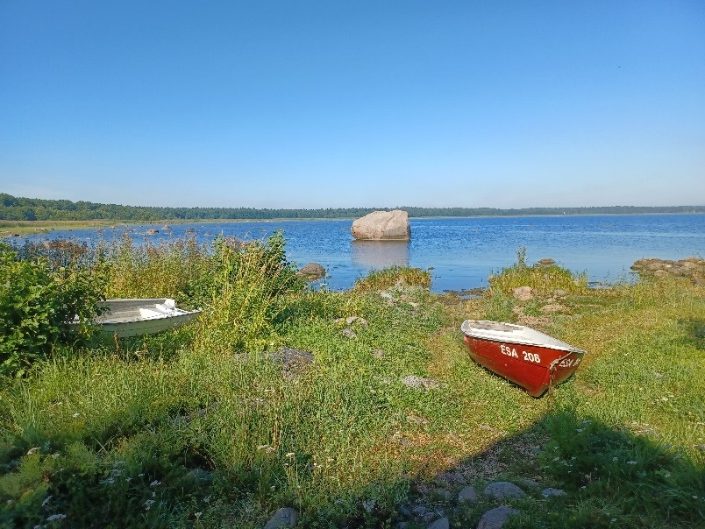
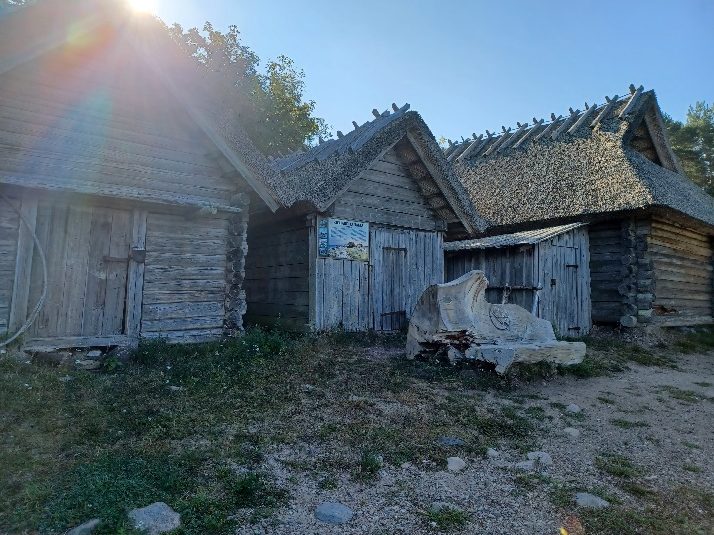
There are a few old Manor houses out here, in their captivating natural surroundings, two of which we visit. They were once owned by German aristocrats, who were driven out by the Soviets and lost their estates. One such was the von Schubert’s Vihula Manor, now a country club and spa, which boasts a water mill and eco farm. I grab a coffee in the Watermill Café. Thence to Palmse Manor, a splendid German baroque manor house, painted yellow with orange tiled roof, once owned by Alexander von der Pahlen. He it was who established the Baltic Railway Society, which built the railway to St Petersburg, opened in 1870. He had his own private stop, I read. The house is now a museum. The rooms have huge ceramic boilers in them and one room has a wooden cabinet stacked with the estate’s own rhubarb red wine. Hmmm. Interesting.
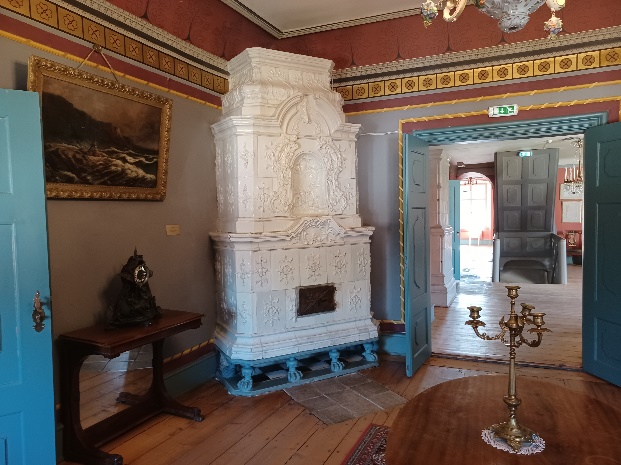
Parked on the gravel track by a white fence is a bright white horse-drawn carriage upon which is perched a lady driver dressed in a long black skirt and black hat. Free rides around the estate are being offered to visitors. Tally-ho! The brown horse clip clops around at a steadyish pace while we ‒ self and Polish friend ‒ sit sedately in the carriage eying the gorgeous gardens with their fruit trees, its orangery full of exotic plants, vegetable patch, labyrinth and large pond, upon which a couple of wigeon are swimming about.
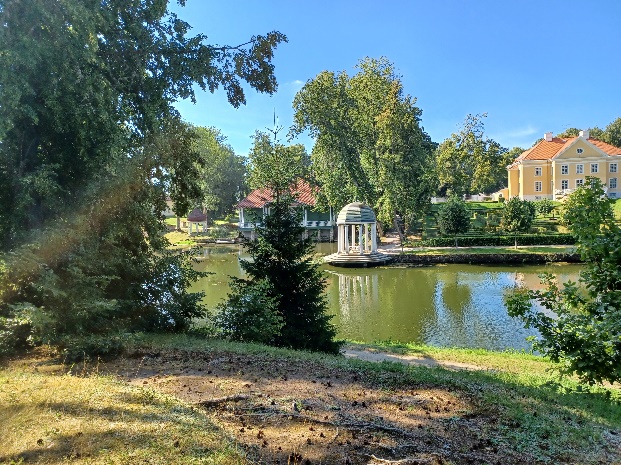
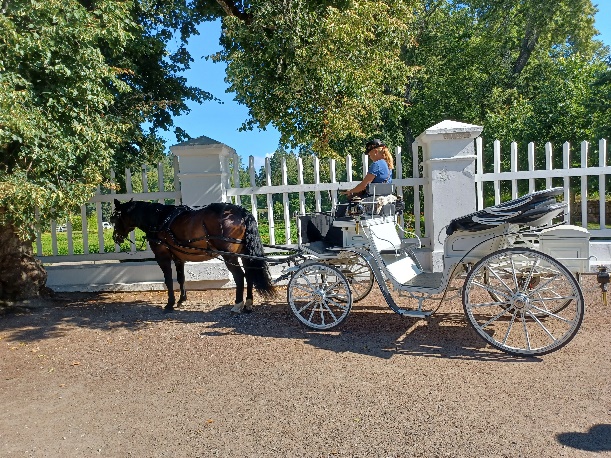
Lunch is taken at an old tavern serving Estonian food. In the garden is an old wooden swing, reminiscent of the old fairgrounds. No doubt placed there for younger visitors, I swing on it with my younger friends. Quite diverting and good exercise of course. Across the road is a tall pole atop which is a twiggy nest. I watch as a stork, red legs outstretched, comes in to land. And, as we resume our journey along the country roads, a white windmill appears in one field and in the next a flock of cranes. Close enough to see their red crowns.
But it is time now to leave them behind to return to Tallinn and the forthcoming flight home. This has been an engaging and thought-provoking tour of the Baltic States with a good mix of lovely countryside and enchanting cities. Moreover, despite the 50 plus members of the group and the different languages, it all turned out rather well.

Leave a Reply